Figure embroidery has been on my mind a lot lately. It’s actually one of my goals for this year, to work a piece of figure embroidery here on Needle ‘n Thread.
But you know those New Year’s resolutions… I figure if I resolve it one year, I’ve got at least five to make it happen. Or at least, that’s how it seems to work out!
In any case, I’ve been doing some reading lately, and the topic is sniggling about in my head, so I want to talk about it. Telling you all about it always helps me to clarify things.
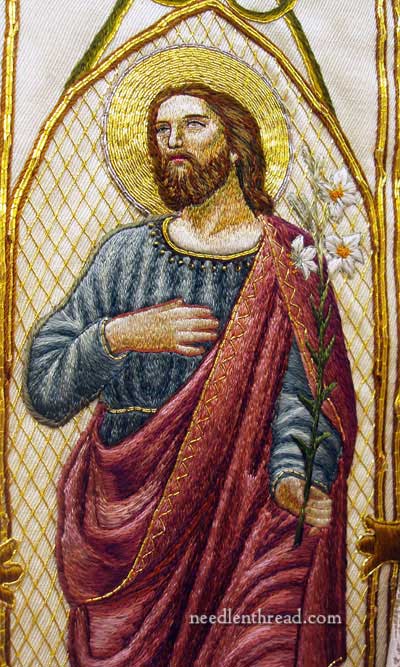
Figure embroidery (pictorial embroidery involving people) is found frequently in ecclesiastical needlework, though it isn’t limited to ecclesiastical needlework. It is popular as well in stumpwork, in the embroideries that embellished 17th century caskets and the like, in tapestry-type embroideries (like the Bayeux Tapestry).
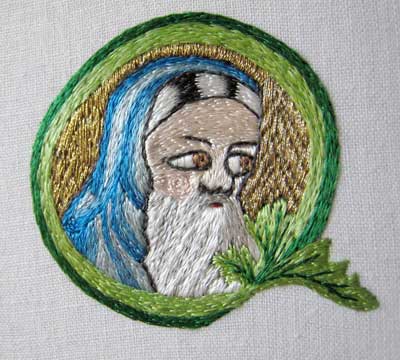
In the medieval embroidery style known as Opus Anglicanum (you can read about and see this Opus Anglicanum sample develop here), figure embroidery takes on a distinctive look. Split stitch is the dominant stitch and those large eyes dominate the face. The faces are filled in split stitch, worked in swirls on the cheeks and outwards.
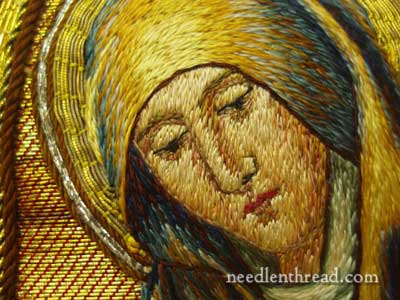
In this more modern figure embroidery, split stitch is still used, but in the form of long and short stitch.
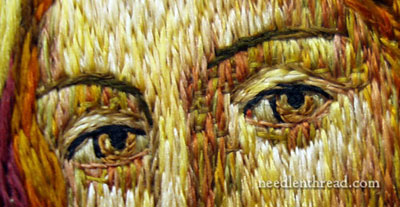
I’m always drawn to the eyes first, when I look at any piece of figure embroidery that involves an embroidered face.
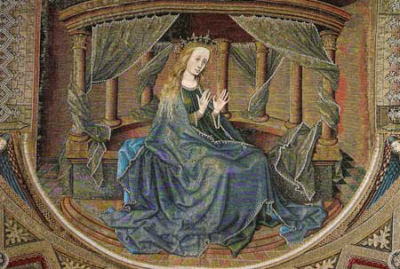
And there are other types of figure embroidery, too – like the figure found on the hood of this cope (the Mantle of the Virgin – 1500’s), which is worked entirely in a goldwork technique called Or Nué, where colored silk threads couch down lines of gold thread, in varying intervals to create an intricately “painted” embroidery.
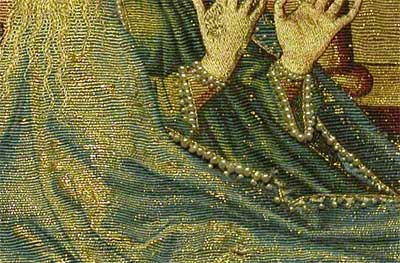
In this close-up photo, you can see the pattern of the horizontal lines of gold thread. Now, that is some amazing figure embroidery!
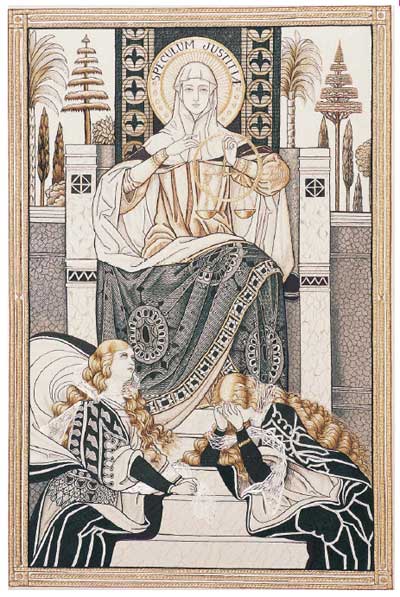
Here’s a more modern approach to figure embroidery, from the exquisite Litany of Loreto embroideries of the Royal School of Needlework.
You can see more detail on these embroideries if you check out the following PDF’s:
Litany of Loreto Embroideries – RSN (PDF)
Embroidery for Places of Worship – RSN (PDF) – this one has a wonderful close-up!
The details I really love in the Loreto embroideries are the decor on the robes, the exquisite eyes (not fully embroidered – they are mostly outlined, it seems), the beautiful hair, and lacy overlays on many of the figures (like the one on the lower right in the photo above), and the use of browns, blacks, and light golden colors, along with gold thread, to create the whole scene. I think they’re exquisite, even though I find the subjects somewhat overly sentimentalized, typical of pre-Raphaelite art.
The Litany of Loreto embroideries demonstrate that beautiful embroidered figures can be worked without full embroidery on the faces, hands, and other areas. The overall effect is much lighter and more delicate than some of the heavier, completely embroidered figures.
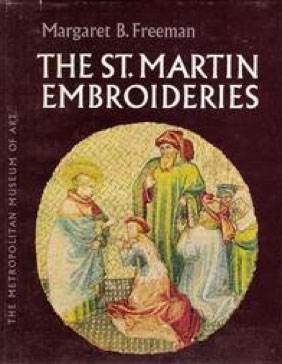
The book I’m reading right now is The St. Martin Embroideries by Margaret Freeman. It’s interesting and informative. It was published by the Metropolitan Museum of Art in 1968, and it studies a collection of Flemish and Franco-Flemish embroideries from the first half of the 15th century. It’s good reading, and the book is loaded with photos, though all but two are black and white. They’re still good photos!
Before I ever sail forward on a specific embroidery tack, I like to do a lot of reading first. To know the history behind any given type of embroidery helps, I think, to have a more “complete” experience in the creation of a new piece. So at this point, I’m reading a lot, researching, tracking down books and the like.
If I come up with a good book list for this particular topic, I’ll definitely share it with you, if you have an interest in figure embroidery, too. If you happen to know of any good books on the topic, I’d love to hear about them.
So what about you? Does pictorial embroidery involving people – whether religious or secular – interest you, too? Do you have any good resources on the subject that you’d like to share? Have you done any similar work that you’d like to show off? Feel free to leave a comment below!







Hello,
I remember the face of an angel embroidered needle painting. I saw a church in Haute Savoie in France. It was a delight. I think I wanted to start this embroidery technique from that time. I want to embroider a face of Madonna, but I do not dare. I am not so good at it. Thank you for your beautiful items so well documented; Sincerely
I saw a piece of the Litany of Loreto embroidery from close, at RNS. It is simply incredible, as if these nun were using hair (or something thinner than hair) for some stitches..
HI Mary,
Thank you for taking up the topic of figure embroidery. I am in the process of studying a few pieces at a monastery, and would be most interested in anything else you might be willing to share on the topic. I’ve already added the book you recommed to my Amazon cart for today!
Hi Mary with a y,
I have seen some incredible pieces of needle embroidery in my time… Because of your preamble I won’t hold my breath (I might expire before you act…), but if you ‘beef up’your discoveries with an introductory course on that skill, I’ll be a devoted follower (urgent other work notwithstanding…) Thanks for the illustrations! I wonder about the degree of enlargement of the pictures you’ve shared. Can you tell us?
Hanny with a y
Thanks for this great info. I was just looking into portrait embroidery 🙂 and found this artist:
http://www.designboom.com/art/cayce-zavaglia-embroidered-portraits/
Cayce also has a video: https://www.youtube.com/watch?v=tE7q43-g8lw
Yes, I do like doing figures. I have done several in the past few years. I started with Crinoline ladies a few years ago, to get bodies and clothing reasonable, and moved on to figures with faces. My latest was a figure on a project the size of a military uniform shoulder patch. You know, about 3 and a half inches. The head is the size od a quarter. I cannot say that it is perfect, but the person it was a gift for loves it.
I like to read, but as far as learning embroidery, I am a hands on, just do it, screw up, do better next time sort of learner. 🙂
Yes,
I love needle painting portraits. I would love
to read more about different methods of figure embroidery. I am working on a series of needle
painted portraits, currently a commissioned piece
from a portrait of Marie Antoinette.
Thank you for this interesting article!
Excuse my ignorance but why is split stitch used? It kind of gives them a hairy look. It seems you’ve shown other pieces where the shading is subtle and the skin looks much smoother.
Hi Mary! I have been fascinated by the wonderful use of fiber in figure embroidery since I saw some wonderful pieces at the Victoria and Albert Museum in London a number of years ago. I believe they were stitched by Mary Linwood, but no matter. The first view from a distance made me think I was seeing a painted portrait, but when I got up close, I was just amazed by her skill a laying the threads to create a painted impression. Her works have never been again on exhibit the many later trips to London I’ve made to my great regret.
Wow, Mary, thank you so much for tackling this area of embroidery! I have been noodling some ideas for figures because I’m working on a piece honoring my female ancestors who’ve passed both their love of all things needle-iscious and their know how on to me. While I’ve incorporated photo-transfers, I really wanted to add some emboidered figures, also. I eagerly await more!
P.S. That seated Virgin done in Or Nue is awesome, and it proves the label “thread painting”! Not to diminish any of the other examples; I’m quite drawn to the Litany of Loreto which while modern also harks back to the Pre-Raphaelites as well as later schools.
Thank you so much for making a study of figural embroidery. I am a machine embroiderer and definitely a fan of your site and newsletter. I find that studying hand embroidery, I understand better how to translate pictures into machine embroidery. I am Greek Orthodox and am starting to embroider icons so this is timely for me. A machine will never be able to do what a human hand and heart can but, given my lack of skill with needle in hand, I feel blessed to have a machine. So very grateful for your work.
Hello, Mary,
I am very excited about the figure embroidery and book and other resources you talk about in today’s email. I am looking forward to finding out more.
Dear Mary
Thanks so much for this post. I’m wondering with your creativity and experience in needlework why you have never attempted figure embroidery before, I can’t wait for you to sail forward on this particular project because I know it will be amazing. Apart from my eggembroidery I’m currently involved in a Guardian Angel project I will post pictures when completed which I hope will be soon as soon as my addiction for eggs has deminshed.
Regards Anita Simmance
Hi, Anita – I have done some figure embroidery, but it was in the pre-Needle ‘n Thread days. It was more “iconic” than what I’m looking for now. I’m really drawn to the style of the Loreto embroideries, actually, as well as to Or Nue used in figure embroidery (though the time involved in the latter is a big drawback!). The fact is, I love it all, and it’s hard to narrow down my own approach. I do have a figure ready to embroider (even transferred onto the fabric!) but I’m Not Quite Sure yet if it’s what I want to do – if I want to put the time into it or not. So, reading and reading and reading helps me hone my own ideas and decide on an approach. Of course, there’s always that problem of reading more than actually doing! So I should just start it! First, though, I have a couple other pieces that need to move into the starting phase, and a couple pieces that are moving into the finishing phase. Ahhhhh…. time! ~MC
Hi Mary,
Love your newsletter. I see where you are thinking of doing something that will incorporate faces. All of your work is so beautiful, but much of it is light years ahead of my ability. I would love to see you do something whimsical with people. I am, entranced with Sieglinde Schoen Smith, and her quilt called Mother earth and her children. Perhaps you would consider doing something along that line too. Thanks for the opportunity to add my comment.
Linda
I am absolutely enthralled with the Loreto pieces and really, really, REALLY want to do a piece based on this series. If the RSN, EGA or let me think, Mary C. ever did this as a tutorial I would leap at the chance to participate. The artistic design of Loreto also reminds me of an artist Sulamith Wulfing.
I still have all those new silks from Mulberry. Hmmm…I’m thinking that this would be a good way to use them.
Mary, didn’t you try doing a portrait of a woman? It was several years ago and you ended pulling out her face which caused her to look the bearded lady.
Have you considered giving her a shave and trying her again?
Yep. That was Proserpina. I think she is more in the style of the Loreto embroideries – without the solid fill on the face. I may take her up again. I worked her hair at one point, and it turned out great! But the trick is finding a fine enough silk of the right color for outlining the eyes and face and hands…
Hi Mary,
If you send me your address I’ll send you a book with some figure embroidery that is done in a monastery in Greece, these nuns are very famous for their goldwork embroidery, absolutely beautiful work.
Mary, I had never thought about figure embroidery- I guess I thought it was a lost art. Thanks for opening up new possibilities! I love your newsletter. Charlotte
This is so much detailed work and it looks great too. Mary, you are a true genius :).
Hi Mary, I am interested in figurative embroidery. I have always enjoyed the pastoral scenes found on 18th and 19th century over mantels, and of course who isn’t in love with the stump work needle caskets. Ecclesiastical needlework was never someting I studied before, but I have to say that after following your daily blog for quite some time now, I have yearning to learn more about this type of needlework. While I know I would never be stitching up a piece of ecclesiastical needlework in my lifetime, I enjoy reading about it. I would, however, love to make a casket for myself someday!!! I have a few stump work books on figure embroidery. Muriel Baker’s Stumpwork, The Art of Raised Embroidery as well as 2 books by Barbara and Roy Hirst, Raised Embroidery, A Practical Guide To Decorative Stumpwork and New Designs In Raised Embroidery are books which I will reference when it comes time to create my casket.
Sandy
Try Valerie Harding’s Faces and Figures in Embroidery from 1979 or either book by Barbara and Roy Hirst. The former is quite contemporary and sometimes abstract, though not always. The Hirst books are on modern raised embroidery. Both of theirs are delightful.
I too have been thinking about painting with threads and especially faces and hands which seem so daunting. I spend much time in Churches in the UK and France looking at the Church banners – returning home inspired but not quite knowing where to start!… and so I never do! I have studied the Byzantine faces and much of the work by the late Beryl Dean – it all seems so easy. How splendid it would be to have a step by step instruction on a weekly basis and maybe by this time next year we shall have achieved a completed head and a hand but that will only happen with your encouragement.
I am still waiting to see your beautiful ecclesiastical embroidery completed and being used to the glory of God.
This is so exciting! I would love to know more about this. The pictures you shared are beautiful. Cannot wait to see what else you come up with. 🙂
Hi Mary,
I would love for this to be a topic you explore in more detail! If I were starting from scratch, my inclination would be to also study some art books on the proportions and ratios necessary to render a face effectively (width between eyes, etc.), and maybe literature on makeup artists (how they layer yellow and then red and then pink, etc. to get the depth of color done correctly on a face. I just watched a YouTube video on how ballerinas paint their faces, and it is so illuminating on how you place color in certain areas so that you can get a better effect from a distance. Some of the faces I see on embroideries are so awkaward and relative to the technical mastery of the rest of the work, I think it is something that requires a practiced and informed eye to get right. I look forward to you shedding light on this topic for us, I think it is so important to achieving a moving experience for the viewer of the art.
Yes, very good point, Irene. I have a whole slew of drawing books for portraiture, and they are very helpful for this! MC
Mary, your articles, your pictures, your books are always so ‘ right on ‘ when it comes to doing any type of embroidery. This is one that I would like to be able to do. Just to have one picture of the Madonna in my home would make my heart complete.Please let us know when you find books or websites on this embroidery form. I find your book on church embroidery so inspirational as well, as you have done a lot of them and brought them to life on your blog. God bless you for sharing such talent with all of us.
In regards to my embroidering a cat for my granddaughter , I found a cookie cutter that worked perfect as a pattern. I am trying to attach a photo of my work , but I don’t know how to do that.
Hi, Valoris – I’m afraid you can’t attach photos in the comments sections on blogs. You’re welcome to send one to me, if you like, or you can post photos in the Ask & Share gallery section here on Needle ‘n Thread, and also on Stitchin’ Fingers (there’s a great selection of photos there). Both spots require you to sign up before you can post photos. Once you’ve posted the photos, you can put a link here in the comments to your particular photo. Also, if you have a Flickr account or something similar, you’re welcome to post a link in the comments section. Hope that helps! ~MC
Hi Mary,
You don´t know how excited I was to read this post!!! I really hope you do start a project this year on figure embroidery. Like I wrote in another post, a Madonna and Child would be amazing to follow from scratch. Thank you!!!
Candice from Barcelona
Mary, You might want to look at the medieval Byzantine/Russian ecclesiastical pictorial embroidery being taught in the U.S. through Hexaemeron (http://www.hexaemeron.org). There are links to the instructor’s website, where there are many high-resolution photos. Techniques are split-stitch and gold couching, including pattern couching. The catalog from the Stroganoff exhibit at the Portland Art Museum has a few pages of color photos, and one two-page layout with a very detailed close-up. Because the number of pages is small, you might just borrow it from the library. Books documenting historical works are being published in Russia now that the government is no longer suppressing the church there.
Hi Mary,
I wanted to ask you a thread related question but can’t find an email address so hope you don’t mind me asking you here.
I recently bought some Perle cotton in 12 and 8 for a project. The instructions said I also needed stranded cotton. I was in our rather limited craft shop and they had Anchor Perle so I picked up that and what I thought was anchor stranded cotton. When I got home, I found out it’s not divisible. The label just says “soft cotton”. Can you shed any light on what it is? Is it Cotton à Broder because I thought that was thinner?
Anchor Soft Cotton is a single, bulky, matt cotton thread – used for big bold stitchery. Stranded Cotton is the usual name for ordinary six-stranded embroidery floss here in the UK, where Anchor is still our most common brand. If you can match the colours you need, DMC or any other good brand can be used instead.
thank you so much for the response, I now just have to find a use for the soft cotton!
Mary,
Figural embroidery is something that always intimidated me but I’ve been thinking about it for awhile. The type that I’ve been thinking most about is the silkwork pictures done in England and America in the early 1800’s where the faces and sometimes the hands were done in penwork or watercolor and the figures were done in flat silk, trees and bushes often done in silk chenille. The slipcase for Betty Ring’s 2 volume “Girlhood Embroidery” has a beautiful memorial one on the front.
Your article also reminded me of “Embroidery Masterworks, classic patterns and techniques for contemporary application” by Virginia Churchill Bath. It’s based on textiles from the collection of the Art Institutes of Chicago. I think this book is out of print but I was able to find a second hand copy a couple of years ago. (Does anyone knows how to get that musty smell out of old books?) It has some patterns for figures based on old needlework, including an angel in silk and gold from a Spanish altar frontal from 1468, a nativity scene from the same piece, Adam & Eve from an English 17th century bible cover, and lots of other tempting but obviously time consuming projects. There isn’t much in the way of instruction in this book but it doesn’t oversimplify the designs to the point that they loose the original beauty the way so many books based on museum collections do.
Side thought: Place the book in a plastic zip bag and place in the freezer to get rid of the musty book smell.
Peggy wrote: “Place the book in a plastic zip bag and place in the freezer to get rid of the musty book smell”
Thanks Peggy I’ll have to try that. I have a book I can’t even open because of the moldy smell.
I doubt I’d want to do a thread painted portrait, but I like the idea of some figurative stumpwork pieces at some point. I may even do some Bible stories, but accurately. I mean, Jesus is often pictured (be it with thread or paint) as being pale and weak looking with longish blond hair, but quite luxurious robes. However, he was a middle Eastern carpenter from a large, poor family in a culture with a religious law that barred men from having long hair! He’d have been simply dressed, medium skinned with dark eyes, neatly trimmed dark hair and beard etc and beefy from all that physical work!=)
Anyway, be that as it may, I fancy treating myself to the ‘Embroidered Portraits’ book, which will be helpful and then maybe I might put a few ideas together….=)
Hi Mary,
Check out http://www.caycezavaglia.com. Not ecclesiastical, but the faces have so much emotion in them. The way she captures the personality of the person in the portraits is really amazing. Can’t wait to see your interpretation of figure embroidery!
Thanks,
Veronica
Hi Mary,
I am a beginner….well, even that is an exaggeration, to be sure. However, I love your site and am blown over with your expert embroidery of faces, etc. WOW! I am also fascinated to see what you are doing embroidering Easter eggs. It is amazing that you come up with one great idea after another. Where did you go to art school?
What you do is beyond art school though…it is more like “heart school” so I am guessing that your creativity and attention to detail must have started at home. I bet you have very talented siblings, too. Be sure to tell your Mom and Dad that they did a great job! I’d love to meet you. so if you ever come to AL, please let me know. I’ll put the coffee on right away, and have lots of munchies on hand as we talk and laugh the whole day through. 🙂
One of your faithful fans,
Arlene
Hi, Arlene! Thanks for your note! I was just in Alabama! We had a delightful time – beautiful weather, too. Got back to the freezing cold in Kansas, and now we’re expecting a good snow over the weekend. And I was just enjoying something like 80 degrees down south! Amazing! 🙂
So stunning! I’m not even going to see if there’s a book on this; every time I read a review I have to get the book. LOL (just ordered the Celtic book earlier this week). Since it’s Lent, I’m going to try to heed the voice inside that whispers, “Use what you already have.” 🙂 Yikes!! I think I’m repenting of craft greed this year. My friend says, since we both have to work so much, we’re trying to buy time to craft when we buy books (I think she’s right!). I’ve made a deal with myself that for every new book that comes in, two have to leave the house. Lovely photos! Thanks for sharing.
its fantastic!!
Its fantastic! It is with single thread? Can you send method of embroidery?
I came across this wonderful posting a bit late in the game, as I was looking for ideas about good colors for accurately rendering darker-colored skins. I agree with an earlier commenter that Cayce Zavaglia’s work is exquisite. My own stitching (www.priscillaperkins.com) is less photorealistic than Zavaglia’s, but like hers, it focuses on contemporary faces (rather than ecclesiastical figures). I’m eager to see how your figural work evolves!
Hello Mary, I’m Dawn and I get your newsletter for which I am very grateful. I have been wanting to learn more about thread painting people since I first began trying more advanced embroidery techniques in the 1990s (I have been embroidering all my life but nothing this advanced). I recognize the stitches you mention here and stumpwork, but I need a lot of practice. I just wanted to thank you, Mary, for your web site and all you teach; how I love the free patterns! I’m disabled and I can’t purchase patterns on Social Security, so I am very grateful. Please keep up the work so that we may all benefit.
~ Dawn ~
Hello Mary. Having recently taken a more serious interest in embroidery, I regularly work from your excellent video tutorials. I have just found your piece on figurative embroidery. This is of great interest to me and would love to know how you get on with your further research. I did find online, a lady who does wonderful portrature in embroidery. I emailed to compliment her and she replied. That’s the beauty of the internet. We sometimes get replies from these extremely talented people. Please post more on your findings and experiments with thread painting, especially portraiture. Kind regards. Sandra
I embroider on a machine for pleasure and I had the honor to do a wolf head for my husband for Christmas a couple of yrs ago. He was so thrilled with it that he has to tell everyone who visits about his special wolf. It seems wherever you are in the room and walk to a different spot, the face(eyes and head) are following you. He loves it. Would you happen to know what this is called? He’s 87 and it really puzzles him.
Thank you for your time.
M. Doster
Hi, Martha, I think it’s called forced perception or something like that. It’s not uncommon in portrait painting. It’s not that the painter does it on purpose. It’s actually the viewer’s brain interpreting what it sees as if it were real. So while we are observing something that is realistic, our brain forces the perception of the moving eyes, because that’s what we see when we look at that thing (whether it’s a person or an animal) in real life.